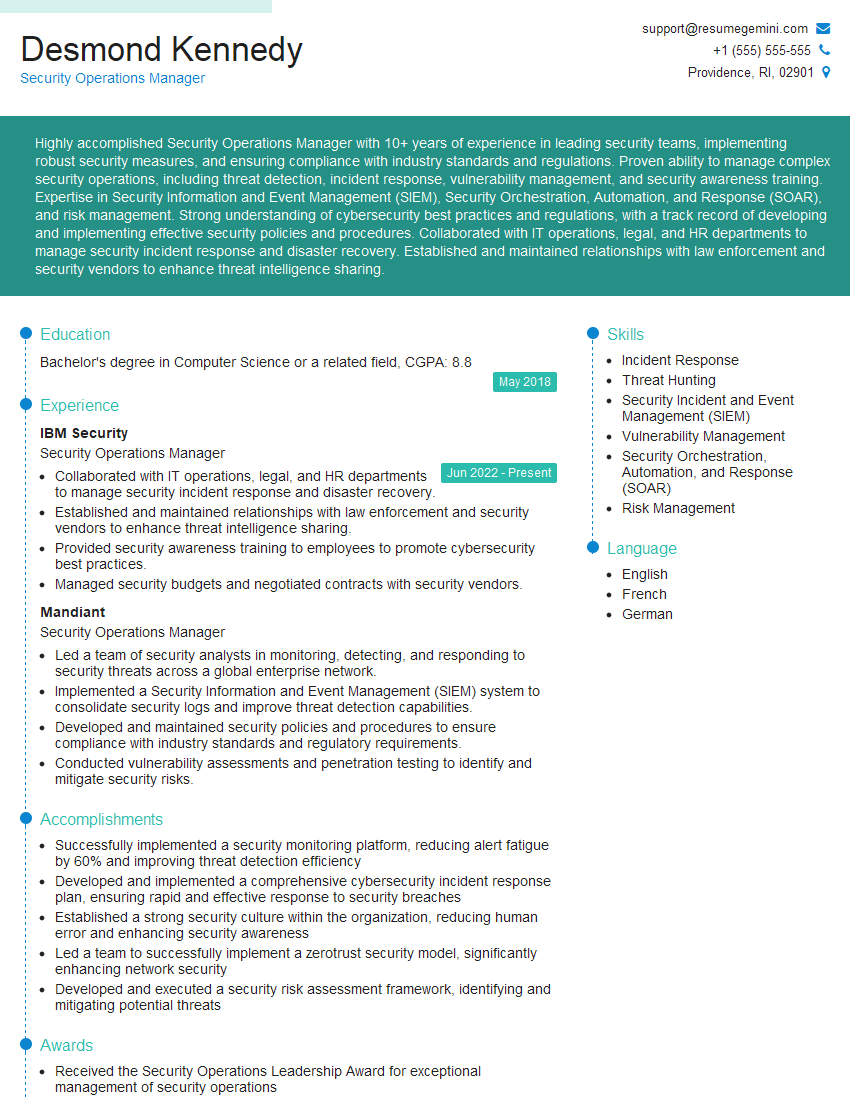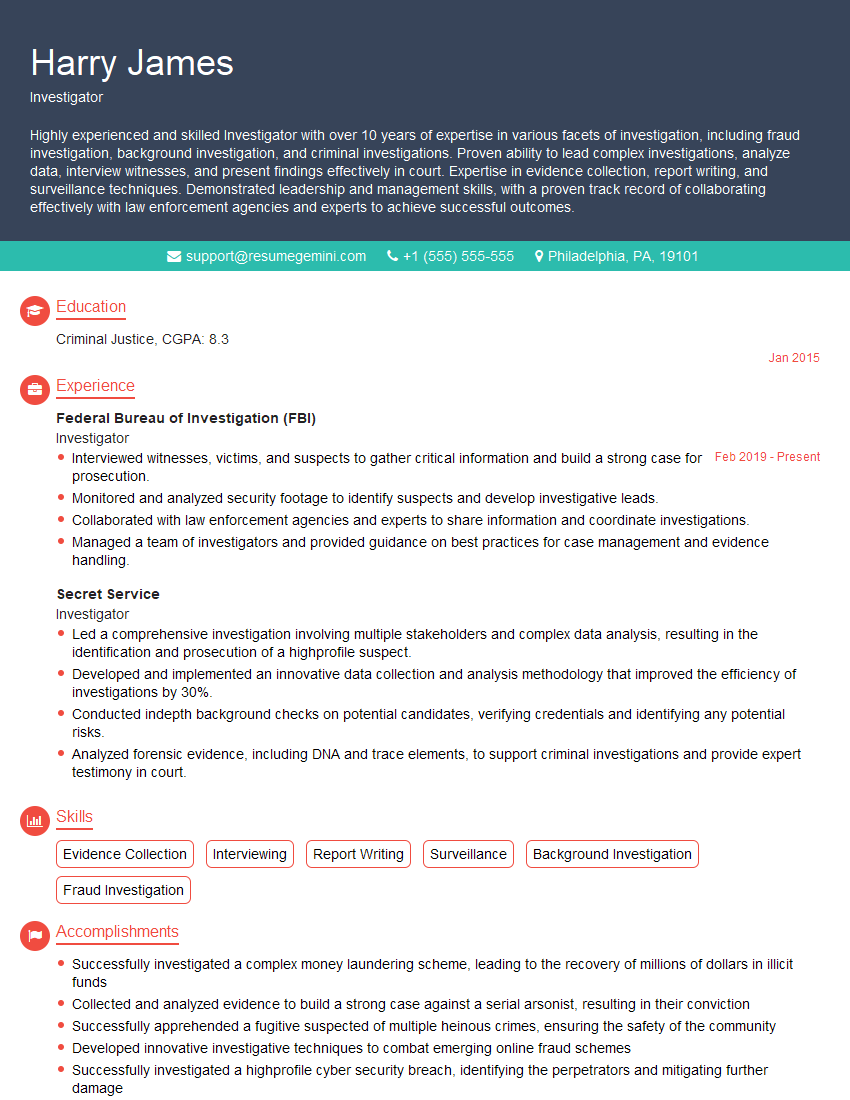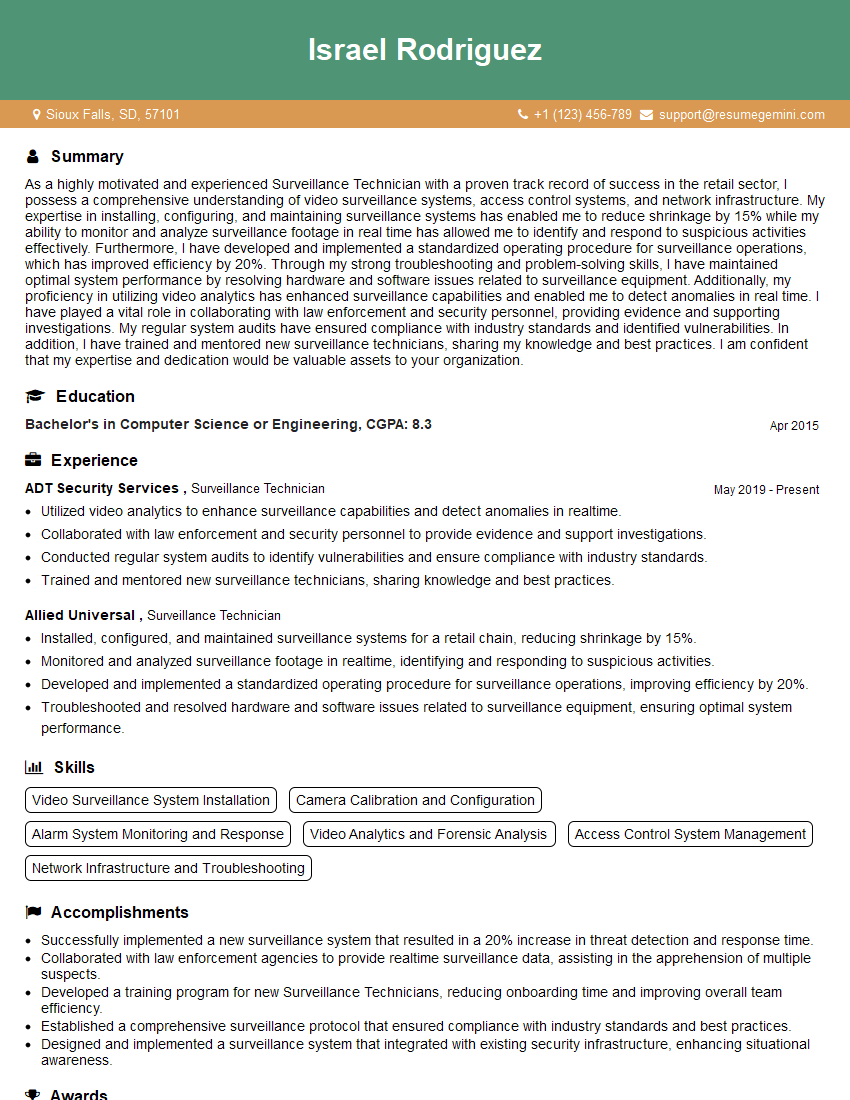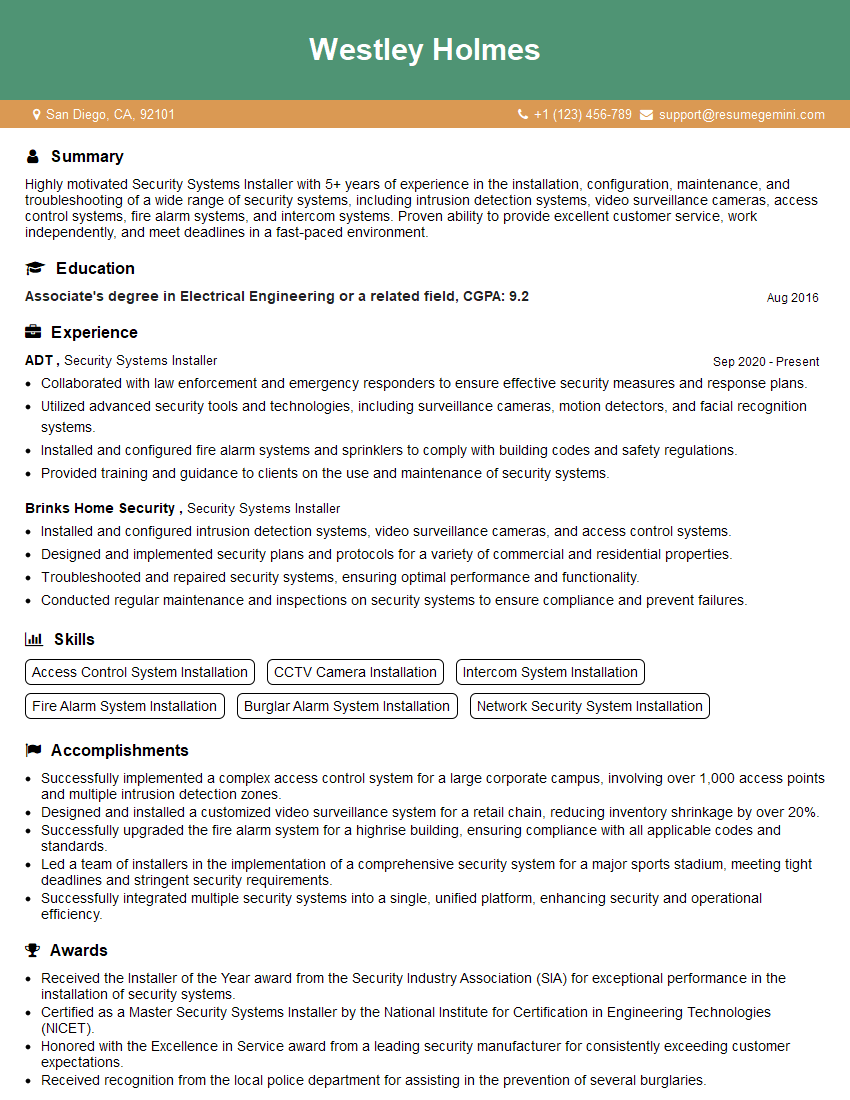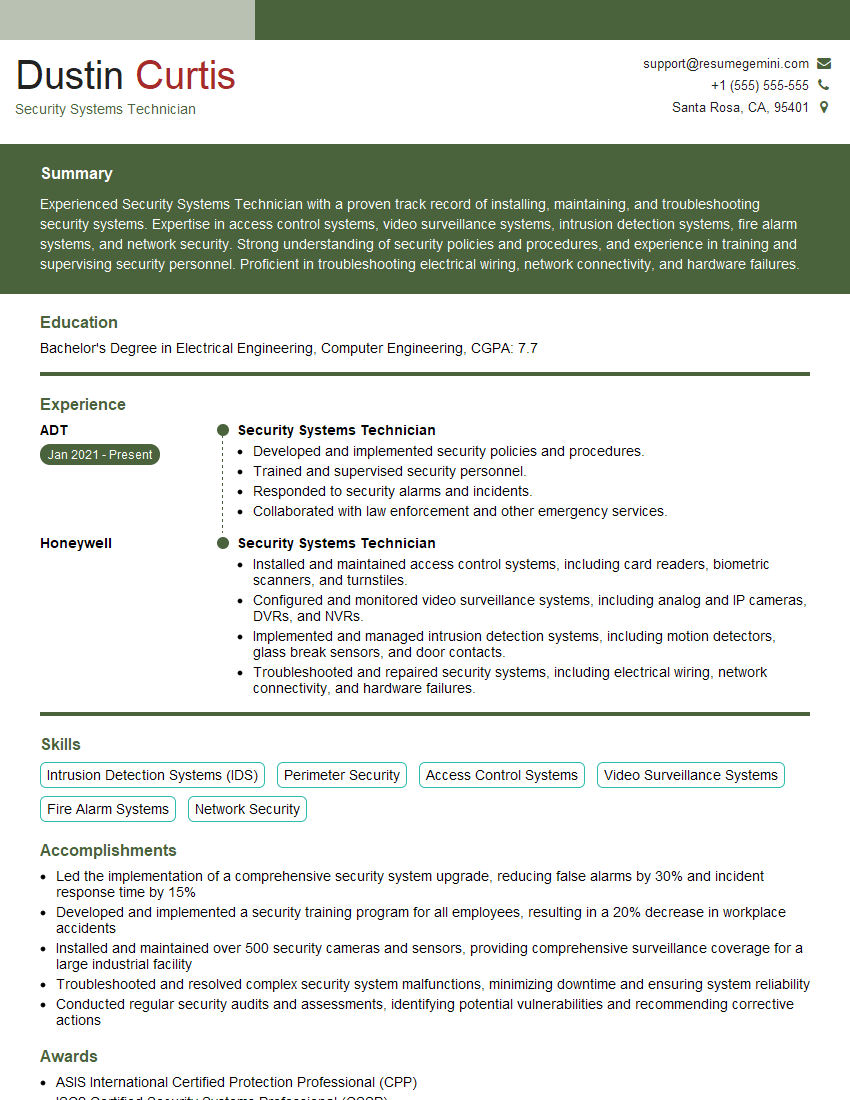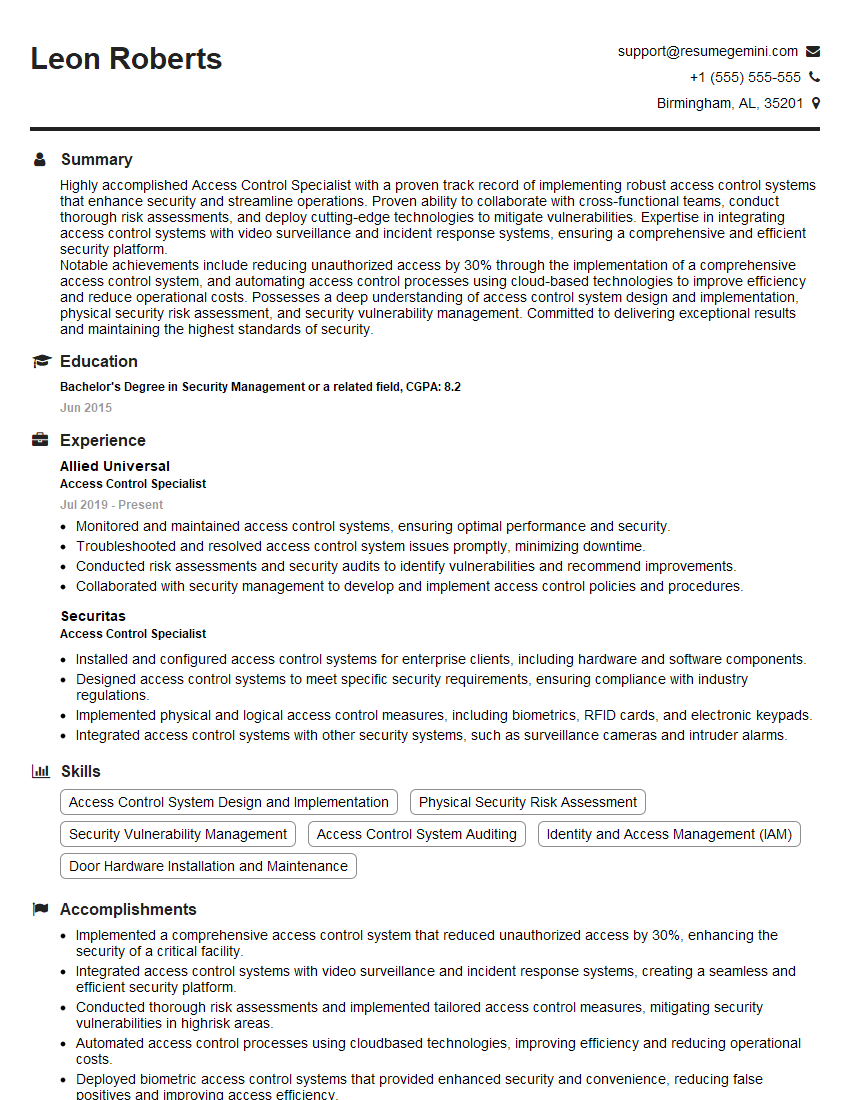Feeling uncertain about what to expect in your upcoming interview? We’ve got you covered! This blog highlights the most important Surveillance and Security Operations interview questions and provides actionable advice to help you stand out as the ideal candidate. Let’s pave the way for your success.
Questions Asked in Surveillance and Security Operations Interview
Q 1. Describe your experience with different types of surveillance systems (CCTV, IP cameras, etc.).
My experience spans a wide range of surveillance systems, from traditional CCTV (Closed-Circuit Television) to modern IP (Internet Protocol) camera networks. CCTV systems, while still prevalent, rely on analog signals and coaxial cabling, offering limited scalability and remote access capabilities. They are generally less expensive upfront but can become costly to maintain and upgrade. I’ve worked extensively with various CCTV brands, troubleshooting issues ranging from faulty cameras to network connectivity problems.
IP cameras, on the other hand, utilize digital technology and network connectivity (typically Ethernet or Wi-Fi), providing superior image quality, remote accessibility, and advanced features like pan-tilt-zoom (PTZ) control and intelligent analytics (e.g., motion detection, facial recognition). My expertise includes configuring and managing IP camera networks, integrating them with video management systems (VMS), and implementing cybersecurity measures to protect against unauthorized access. I have hands-on experience with brands like Hikvision, Axis, and Milestone.
Beyond these core technologies, I’m also familiar with specialized surveillance systems, including thermal cameras for low-light conditions, license plate recognition (LPR) systems, and drone-based surveillance. Each system presents unique challenges and opportunities, and my approach always involves careful consideration of factors like budget, environment, and specific security needs.
Q 2. Explain your understanding of access control systems and their integration with surveillance.
Access control systems manage who can enter specific areas. They range from simple keypads and card readers to sophisticated biometric systems (fingerprint, facial recognition) and cloud-based access management platforms. The integration with surveillance is crucial for enhancing security. When an unauthorized access attempt occurs, the access control system logs the event, triggering an alert that can be viewed on the surveillance system. This allows security personnel to quickly review the corresponding footage, investigate the incident, and take appropriate action.
For example, if someone tries to enter a restricted area using a fraudulent access card, the access control system will record the event and time stamp it. The surveillance system can then display footage showing the individual’s actions, potentially identifying them and providing valuable evidence. This integration streamlines investigations and provides a more complete picture of security events. I’ve worked on projects involving various access control systems, from integrating simple card readers with basic CCTV systems to designing sophisticated, integrated security systems for large facilities using enterprise-level access control and video management software.
Q 3. How would you handle a security breach or incident?
Handling a security breach follows a structured protocol. First, I would prioritize ensuring the safety and security of personnel and assets. Then, I would immediately initiate incident response procedures. This includes isolating the affected system(s) to prevent further damage or data exfiltration. Depending on the nature of the breach (e.g., physical intrusion, cyberattack, data theft), I would involve relevant authorities such as law enforcement and potentially IT forensics specialists.
Next, I would gather evidence: This might involve reviewing surveillance footage, analyzing system logs, and conducting interviews. The goal is to understand the nature, extent, and root cause of the breach. A thorough post-incident analysis is vital to implement corrective actions and prevent future incidents. This analysis would involve identifying vulnerabilities, updating security protocols, and potentially retraining staff. Throughout the process, meticulous documentation is critical to ensure legal and regulatory compliance and facilitate future investigations.
For example, in a case of physical intrusion, I would analyze the surveillance footage to identify the intruder, determine their method of entry, and establish a timeline of events. If the breach involved a cyberattack, I would work with IT security specialists to trace the source, determine the affected systems, and restore data integrity.
Q 4. What are the key components of a comprehensive security risk assessment?
A comprehensive security risk assessment identifies potential threats and vulnerabilities to an organization’s assets. It’s a systematic process that involves several key components:
- Asset Identification: Identifying all critical assets (physical and digital) that need protection. This includes equipment, data, personnel, and intellectual property.
- Threat Assessment: Identifying potential threats, both internal and external, that could compromise assets. These include natural disasters, cyberattacks, physical intrusion, theft, and insider threats.
- Vulnerability Analysis: Identifying weaknesses in security systems and procedures that could be exploited by threats. This includes physical security vulnerabilities (weak access control, inadequate lighting) and technological vulnerabilities (unpatched software, weak passwords).
- Risk Analysis: Assessing the likelihood and potential impact of each threat exploiting each vulnerability. This involves assigning risk scores based on the probability and severity of each risk.
- Risk Mitigation: Developing strategies and implementing controls to reduce or eliminate identified risks. This includes security technology (e.g., intrusion detection systems, firewalls), procedural changes (e.g., enhanced access control policies, staff training), and physical security upgrades (e.g., improved lighting, security cameras).
- Contingency Planning: Developing plans for handling security incidents, including incident response procedures, data recovery plans, and business continuity plans.
The assessment should be regularly reviewed and updated to reflect changing threats and vulnerabilities.
Q 5. Describe your experience with analyzing surveillance footage to identify threats or incidents.
Analyzing surveillance footage is a crucial aspect of security operations. My experience includes using video management systems (VMS) to review recordings, identify suspicious activity, and extract evidence for investigations. This process often involves searching for specific events, such as unauthorized access attempts, unusual behavior, or accidents. Advanced video analytics features, such as motion detection and facial recognition, can significantly aid in this process.
For instance, I once analyzed footage to identify the perpetrator of a theft. By carefully reviewing the recordings, zooming in on key areas, and using time-lapse functions, I was able to clearly identify the individual, their actions, and their escape route. This evidence was instrumental in law enforcement’s investigation and subsequent arrest. Furthermore, I’m proficient in exporting specific video clips and stills for evidence purposes, ensuring the integrity and admissibility of the material in legal proceedings.
Q 6. Explain your familiarity with different types of security protocols and encryption methods.
My familiarity with security protocols and encryption methods is extensive. I understand various protocols, including TCP/IP, HTTPS, and VPNs, crucial for secure network communication and data transmission in surveillance systems. On the encryption side, I have hands-on experience with various methods, from basic symmetric encryption to more sophisticated asymmetric encryption using public and private keys.
For example, I understand the importance of using HTTPS for secure web access to VMS and IP cameras, preventing unauthorized access to sensitive data. Similarly, I’m experienced in deploying VPNs to establish secure connections between remote sites and central monitoring stations, safeguarding data transmitted over public networks. Understanding and implementing strong encryption is essential for protecting video footage and other sensitive data from unauthorized access and interception.
Q 7. How do you ensure the legal and ethical compliance of surveillance activities?
Ensuring legal and ethical compliance in surveillance is paramount. This involves adhering to all applicable laws and regulations, including data privacy laws (e.g., GDPR, CCPA), and maintaining ethical standards concerning data collection, storage, and usage.
Key aspects include obtaining proper consent for surveillance, establishing clear privacy policies, and limiting data retention periods to what’s necessary. Regular audits and training are crucial to maintain compliance. Furthermore, surveillance footage must be handled responsibly, ensuring its use is justified and proportionate to the risks. My approach focuses on implementing transparent surveillance practices that respect individuals’ rights and comply with all legal requirements. For example, when deploying surveillance cameras in public areas, I make sure to clearly indicate their presence through signage and comply with local regulations regarding their placement and usage.
Q 8. Describe your experience with intrusion detection systems (IDS) and intrusion prevention systems (IPS).
Intrusion Detection Systems (IDS) and Intrusion Prevention Systems (IPS) are critical components of a robust security infrastructure. An IDS passively monitors network traffic and system activities for malicious behavior, generating alerts when suspicious events are detected. Think of it as a security guard watching security cameras – they see something suspicious but don’t directly intervene. An IPS, on the other hand, actively blocks or prevents malicious activity. It’s like a security guard who not only sees a suspicious person but also physically prevents them from entering the building.
In my experience, I’ve deployed and managed both signature-based and anomaly-based IDS/IPS solutions. Signature-based systems identify threats based on known patterns (signatures) of malicious activity, while anomaly-based systems detect deviations from established baselines. I’ve worked with various vendors, including Snort, Suricata, and Cisco IPS, configuring them to integrate with SIEM systems for centralized logging and analysis. For example, I once used Snort to detect a SQL injection attempt on a web server, which then triggered an alert in our SIEM, allowing for rapid response and mitigation.
A crucial aspect of IDS/IPS management is tuning the systems to minimize false positives while ensuring that genuine threats are detected. This involves understanding the specific security needs of the environment and carefully adjusting thresholds and rules based on factors such as network traffic patterns and the types of applications running on the systems being protected.
Q 9. What is your experience with SIEM (Security Information and Event Management) systems?
Security Information and Event Management (SIEM) systems are the central nervous system of any robust security operation. They aggregate security logs from various sources – network devices, servers, applications, and security tools – into a single, unified view. Imagine it as a control center for a city’s security, aggregating data from all police precincts, cameras, and emergency responders. This centralized view allows security analysts to effectively monitor, detect, and respond to security events across the entire organization.
My experience with SIEMs encompasses deployment, configuration, and management of leading solutions like Splunk and QRadar. I’ve used them to correlate events, identify security incidents, generate reports, and assist in forensic investigations. For example, I once used QRadar to detect a sophisticated phishing campaign by correlating login failures from various locations with suspicious email activity, which allowed us to contain the attack before significant damage occurred. SIEMs also play a vital role in compliance audits, allowing for easy demonstration of compliance with regulations like GDPR and HIPAA.
Effective SIEM management requires a deep understanding of log parsing, rule creation, and correlation techniques. It also involves ongoing maintenance and tuning to ensure optimal performance and accuracy.
Q 10. How do you prioritize security threats and vulnerabilities?
Threat and vulnerability prioritization is a critical skill in security operations. It’s not about fixing everything at once, but about focusing on the most impactful threats first. I use a combination of quantitative and qualitative factors to prioritize. A common framework is the DREAD model:
- Damage Potential: How severe would the impact be if this vulnerability is exploited?
- Reproducibility: How easy is it to exploit the vulnerability?
- Exploitability: How much technical expertise is required to exploit the vulnerability?
- Affected Users: How many users or systems are affected?
- Discoverability: How easily can attackers find and exploit the vulnerability?
I also consider the business context: vulnerabilities impacting critical systems or sensitive data are prioritized higher than those with minimal impact. For instance, a vulnerability affecting a database containing customer credit card information would be prioritized much higher than a vulnerability on a non-critical internal web server. Risk scoring tools and vulnerability management platforms automate parts of this process, but human judgment and experience remain crucial in the overall assessment.
Q 11. Explain your understanding of network security principles relevant to surveillance systems.
Network security is paramount for surveillance systems, as they often involve sensitive data and critical infrastructure. The principles here mirror those of any robust network architecture, but with some unique considerations. Key aspects include:
- Network Segmentation: Isolating surveillance cameras and recording devices from the rest of the network prevents attackers from compromising the entire infrastructure through a single point of entry. Think of it as creating secure zones within a building.
- Firewall Management: Firewalls filter traffic in and out of the surveillance network, blocking unauthorized access. Careful rule configuration is vital to balance security and functionality.
- Intrusion Detection/Prevention: IDS/IPS systems monitor for malicious activity and can block or alert on suspicious events targeting the surveillance network.
- Secure Protocols: Using secure protocols like HTTPS for remote management and data transmission prevents eavesdropping and data tampering.
- Access Control: Restricting access to the surveillance system to only authorized personnel through robust authentication and authorization mechanisms is essential.
- Data Encryption: Encrypting video feeds and stored recordings prevents unauthorized access to sensitive information, even if the network is compromised.
Failure to implement these security measures can result in serious consequences, ranging from unauthorized access to video footage to complete system compromise.
Q 12. How would you design a security system for a high-value asset?
Designing a security system for a high-value asset requires a layered, multi-faceted approach, often termed ‘defense in depth.’ This involves combining various security measures to ensure that even if one layer is compromised, others remain in place to protect the asset.
For example, securing a high-value data center might involve:
- Physical Security: Perimeter fencing, access control systems (card readers, biometric scanners), security guards, and CCTV cameras.
- Network Security: Firewall protection, intrusion detection/prevention, network segmentation, VPNs for remote access, and regular vulnerability scans.
- Data Security: Encryption of data at rest and in transit, access control lists, regular backups, and disaster recovery planning.
- Application Security: Secure coding practices, regular penetration testing, web application firewalls, and input validation.
- Monitoring and Alerting: SIEM systems to monitor for anomalies, log management, and real-time threat intelligence feeds.
- Incident Response Plan: A documented plan for responding to security incidents, including procedures for containment, eradication, and recovery.
The specific design will depend on the nature of the asset, the potential threats, and the acceptable risk level. Regular risk assessments and security audits are critical to ensure the system remains effective over time.
Q 13. Describe your experience with vulnerability assessments and penetration testing.
Vulnerability assessments and penetration testing are crucial for identifying and mitigating security weaknesses. A vulnerability assessment is a systematic scan of systems and networks to identify potential vulnerabilities. It’s like a medical checkup – finding potential problems before they become serious issues. Penetration testing, on the other hand, is a simulated attack that tests the effectiveness of security controls. It’s like a stress test – pushing the systems to their limits to see how well they hold up under pressure.
My experience includes conducting both automated and manual vulnerability assessments using tools like Nessus and OpenVAS. I’ve also performed various penetration tests, employing both black-box (no prior knowledge of the system) and white-box (with complete system knowledge) methodologies. For example, I once identified a critical vulnerability in a web application during a penetration test, which allowed attackers to gain unauthorized access to sensitive data. This allowed the organization to patch the vulnerability before attackers could exploit it.
The results of these assessments are used to prioritize remediation efforts, focusing on the most critical vulnerabilities first. Detailed reports outlining the identified vulnerabilities, their severity, and remediation recommendations are provided to management for decision-making.
Q 14. How do you maintain and update surveillance and security systems?
Maintaining and updating surveillance and security systems is an ongoing process, crucial for ensuring their effectiveness and preventing vulnerabilities. This involves several key activities:
- Software Updates: Regularly patching operating systems, applications, and firmware on all devices to address known vulnerabilities. This is perhaps the most important step, preventing many attacks.
- Hardware Maintenance: Regularly inspecting and maintaining hardware components, replacing failing equipment promptly, and ensuring proper environmental conditions to prevent damage.
- Security Monitoring: Continuously monitoring security logs for suspicious activity, proactively identifying and responding to security threats.
- Backup and Recovery: Regularly backing up surveillance recordings and system configurations to protect against data loss or system failures. Testing the recovery process is crucial.
- Security Audits: Periodically conducting security audits to assess the overall effectiveness of the security system and identify areas for improvement. This might involve penetration testing and vulnerability assessments.
- Policy Updates: Regularly reviewing and updating security policies and procedures to address changes in the threat landscape and organizational needs.
- Staff Training: Providing security awareness training to staff to educate them on security best practices and their responsibilities.
Implementing a robust maintenance plan and following these procedures significantly reduces the risk of security breaches and ensures that the surveillance and security systems operate reliably and effectively.
Q 15. What are the common challenges you face in surveillance and security operations?
Surveillance and security operations present a unique set of challenges. One major hurdle is the sheer volume of data generated by modern systems. Analyzing this data efficiently and effectively, extracting meaningful insights, and acting upon them in a timely manner is a constant challenge. Think of it like trying to find a specific grain of sand on a vast beach – it requires sophisticated tools and techniques.
- Data Overload: Modern systems generate terabytes of data daily, making manual analysis impractical. We need robust automated systems for filtering, analyzing, and alerting on critical events.
- False Positives: Automated systems can generate many false alarms, requiring human intervention to filter them out. This can lead to alert fatigue and missed genuine threats.
- Integration Challenges: Integrating various surveillance systems (CCTV, access control, intrusion detection) and data sources into a cohesive security information and event management (SIEM) system can be complex and time-consuming.
- Budget Constraints: Implementing and maintaining advanced security technologies can be expensive, often requiring a careful balancing act between risk mitigation and budget limitations.
- Staffing and Training: Finding and retaining qualified personnel with the necessary skills to manage complex surveillance and security systems is a persistent challenge.
Career Expert Tips:
- Ace those interviews! Prepare effectively by reviewing the Top 50 Most Common Interview Questions on ResumeGemini.
- Navigate your job search with confidence! Explore a wide range of Career Tips on ResumeGemini. Learn about common challenges and recommendations to overcome them.
- Craft the perfect resume! Master the Art of Resume Writing with ResumeGemini’s guide. Showcase your unique qualifications and achievements effectively.
- Don’t miss out on holiday savings! Build your dream resume with ResumeGemini’s ATS optimized templates.
Q 16. Explain your experience with incident reporting and documentation.
Incident reporting and documentation are crucial for maintaining accountability, improving security posture, and meeting legal and regulatory requirements. My process involves a structured approach, ensuring consistent and thorough reporting.
- Immediate Response: Upon detecting an incident, I prioritize immediate action to mitigate the impact (e.g., containing a breach, preventing further damage).
- Detailed Documentation: I meticulously document all aspects of the incident including timestamps, affected systems, potential causes, actions taken, and outcomes. This documentation often includes screenshots, log files, and witness statements.
- Incident Classification: I categorize incidents based on severity (e.g., low, medium, high) and type (e.g., intrusion attempt, data breach, equipment failure) to prioritize responses and track trends.
- Root Cause Analysis: After containment, I conduct a thorough root cause analysis to understand the underlying vulnerabilities that allowed the incident to occur, preventing similar incidents in the future.
- Reporting and Follow-up: I prepare comprehensive reports detailing the incident, root cause analysis, and implemented mitigation strategies. This information is shared with relevant stakeholders and used to update security policies and procedures.
For example, in a recent incident involving unauthorized access to a secure server room, I documented the time of entry, the method of access (compromised keycard), the individuals involved, and the actions taken to secure the room and change access codes. The report also included recommendations for improving keycard security measures and access logs.
Q 17. How do you ensure the security and integrity of surveillance data?
Ensuring the security and integrity of surveillance data is paramount. It requires a multi-layered approach that encompasses physical, technical, and procedural safeguards.
- Data Encryption: All surveillance data, both in transit and at rest, is encrypted using strong encryption algorithms (e.g., AES-256) to protect against unauthorized access.
- Access Control: Strict access control measures are implemented, limiting access to authorized personnel only using role-based access control (RBAC). Access is logged and monitored.
- Data Backup and Recovery: Regular backups of surveillance data are performed and stored securely in a separate location, allowing for data restoration in case of loss or damage.
- Intrusion Detection Systems (IDS): Network intrusion detection systems monitor network traffic for malicious activity, alerting us to any attempts to compromise the surveillance system.
- Regular Audits: Regular security audits are conducted to assess the effectiveness of security measures and identify potential vulnerabilities. Penetration testing is also performed to simulate real-world attacks.
- Physical Security: The physical location of surveillance equipment and data storage is secured, limiting physical access and protecting against theft or damage.
Q 18. How do you utilize data analytics to improve security operations?
Data analytics plays a crucial role in improving security operations. By analyzing surveillance data, we can identify patterns, predict potential threats, and optimize resource allocation.
- Threat Detection: Analyzing video feeds, access logs, and other data using machine learning algorithms can help identify suspicious activities, such as unusual access patterns or loitering individuals, allowing for proactive intervention.
- Predictive Policing: Analyzing historical data on crime patterns can help predict high-risk areas and times, enabling proactive deployment of security personnel and resources.
- Performance Monitoring: Analyzing system performance data can identify bottlenecks and areas for improvement, ensuring the reliability and efficiency of surveillance systems.
- Resource Optimization: Data analytics can help optimize resource allocation, determining the optimal placement of cameras and security personnel based on risk assessments and historical data.
For example, by analyzing historical data on theft incidents, we identified a pattern of break-ins occurring during late-night hours in a specific area. This led to increased nighttime patrols and improved lighting, resulting in a significant reduction in theft incidents.
Q 19. Describe your experience with different types of security audits.
I have experience with various types of security audits, including vulnerability assessments, penetration testing, and compliance audits. Each type serves a different purpose in assessing and strengthening security posture.
- Vulnerability Assessments: These audits identify potential weaknesses in systems and applications, such as outdated software or misconfigured settings. They are often automated, scanning systems for known vulnerabilities.
- Penetration Testing: This involves simulating real-world attacks to identify exploitable vulnerabilities. Ethical hackers attempt to breach security systems to uncover weaknesses and evaluate the effectiveness of security controls.
- Compliance Audits: These audits ensure that security practices adhere to industry standards and regulations (e.g., GDPR, HIPAA). They assess adherence to specific policies and procedures.
In a recent compliance audit, we reviewed our access control procedures against industry best practices to ensure compliance with data protection regulations. This led to improvements in access control logging and user authentication procedures.
Q 20. How do you stay current with the latest threats and vulnerabilities in surveillance and security?
Staying current with the latest threats and vulnerabilities is essential in the ever-evolving landscape of cybersecurity. I employ several strategies to keep my knowledge up-to-date.
- Industry Publications and Conferences: I regularly read industry publications, attend conferences, and participate in webinars to learn about emerging threats and best practices.
- Threat Intelligence Feeds: I subscribe to threat intelligence feeds that provide real-time information on new vulnerabilities and attacks.
- Security Certifications: I maintain relevant security certifications (e.g., CISSP, CompTIA Security+), demonstrating my commitment to continuous professional development.
- Online Courses and Training: I regularly participate in online courses and training programs to enhance my technical skills and knowledge of new technologies.
- Networking: I actively engage with other security professionals through online forums and professional organizations to share information and learn from others’ experiences.
Q 21. What is your experience with physical security measures (e.g., access control, perimeter security)?
My experience with physical security measures encompasses a wide range of technologies and strategies, focusing on layered security approaches.
- Access Control Systems: I have experience designing and implementing access control systems, including keycard systems, biometric authentication, and video surveillance integrated with access control.
- Perimeter Security: This involves designing and implementing security measures to protect the perimeter of a facility, including fencing, lighting, intrusion detection systems, and CCTV cameras.
- Security Assessments: I conduct physical security assessments to identify vulnerabilities and recommend improvements, such as enhancing lighting, improving landscaping to reduce hiding spots, and installing additional security cameras.
- Emergency Response Plans: I participate in the development and implementation of emergency response plans, including procedures for evacuations, lockdowns, and handling various security incidents.
For instance, in a recent project, I integrated a new access control system with existing CCTV cameras, allowing for real-time monitoring of access points and generating automated alerts in case of unauthorized entry. This improved response times to security breaches significantly.
Q 22. How do you collaborate with other teams to ensure overall security?
Effective security relies heavily on cross-functional collaboration. In my experience, this involves regular communication and joint problem-solving with IT, network engineering, physical security, and even legal and HR teams. For instance, when implementing a new access control system, I collaborate with IT to ensure seamless integration with existing network infrastructure, with physical security to coordinate placement of cameras and sensors, and with HR to develop appropriate access policies and training for employees. This collaborative approach ensures a holistic security posture, minimizing vulnerabilities and maximizing effectiveness. We often use shared task management tools and regular meetings (both formal and informal) to track progress, address challenges and share relevant information in a timely manner. A well-defined communication plan is vital, specifying who is responsible for what and how to escalate incidents.
Q 23. Explain your understanding of cybersecurity frameworks (e.g., NIST, ISO 27001).
Cybersecurity frameworks provide a structured approach to managing and mitigating risks. NIST (National Institute of Standards and Technology) Cybersecurity Framework and ISO 27001 are two prominent examples. NIST offers a flexible, risk-based approach, focusing on identifying, assessing, managing, responding to, and recovering from cybersecurity events. It helps organizations develop a customized security program aligned with their specific needs. ISO 27001, on the other hand, is an internationally recognized standard for information security management systems (ISMS). It provides a comprehensive framework for establishing, implementing, maintaining, and continually improving an ISMS. I’ve utilized both frameworks extensively. For example, while implementing security controls for a large-scale surveillance system, we leveraged NIST’s guidelines for risk assessment to prioritize our efforts and align them with business objectives. We then applied ISO 27001 principles to document our processes, control our access privileges, and monitor our systems for compliance and continuous improvement. This dual approach provided a robust and well-documented security posture.
Q 24. Describe your experience with security awareness training programs.
Security awareness training is crucial for building a strong security culture. I’ve developed and delivered numerous training programs, incorporating various methods like interactive workshops, online modules, phishing simulations, and gamification to engage participants effectively. For instance, I once developed a phishing simulation that mimicked realistic phishing attempts, leading employees to report suspicious emails. This simulation helped employees learn to identify and avoid phishing attacks, improving overall security awareness. We always tailor the training to the specific roles and responsibilities of the employees, ensuring that the training is relevant and engaging. We also use metrics like the number of reported phishing attempts and employee engagement in training modules to measure the success of our programs and make continuous improvements. Regular refreshers are essential to maintain awareness in the face of evolving threats.
Q 25. How would you respond to a denial-of-service attack targeting surveillance systems?
A denial-of-service (DoS) attack on surveillance systems requires a multi-pronged approach. First, I would immediately confirm the attack by analyzing network traffic and system logs. Then, I’d initiate our incident response plan. This involves:
- Mitigation: This includes blocking malicious traffic at the network perimeter using firewalls and intrusion prevention systems (IPS). We might also implement rate-limiting to control the flow of traffic to our surveillance servers.
- Isolation: If possible, we would isolate the affected systems from the network to prevent the attack from spreading.
- Investigation: We’d conduct a thorough investigation to identify the source of the attack and the vulnerabilities exploited.
- Recovery: Once the attack is mitigated, we would restore affected systems from backups and ensure their normal functionality.
- Prevention: After the incident, we’d review our security controls to identify and address any vulnerabilities that were exploited during the attack. This could involve upgrading our network infrastructure, implementing more robust security protocols, or improving our network segmentation.
Throughout the process, we’d maintain close communication with relevant stakeholders and document every step of the response to aid in future incident analysis.
Q 26. Explain your experience with implementing and managing security budgets.
Managing security budgets requires a balance between cost-effectiveness and ensuring strong security. My experience includes creating detailed budget proposals, justifying expenditures to management, and tracking spending against allocated funds. I use a risk-based approach, prioritizing investments that address the most significant threats to our organization. For example, if our risk assessment indicates a high likelihood of ransomware attacks, we would prioritize investments in endpoint detection and response (EDR) solutions and employee training. We regularly review our budget allocation, looking for opportunities to optimize spending and ensure we’re getting the best value for our investments. This includes negotiating contracts with vendors, exploring cost-effective solutions, and ensuring all purchases are aligned with our overall security strategy. We use project management software to track expenses, deadlines, and deliverables.
Q 27. How do you measure the effectiveness of security measures?
Measuring the effectiveness of security measures is crucial to ensure our investments are providing a return. We use a combination of quantitative and qualitative metrics. Quantitative metrics include things like the number of security incidents, mean time to resolution (MTTR) for incidents, the number of vulnerabilities discovered and remediated, and the percentage of employees completing security awareness training. Qualitative metrics include employee satisfaction with security measures and the perception of security among staff. Regular penetration testing, vulnerability assessments, and security audits are crucial for identifying weaknesses in our defenses. We also conduct post-incident reviews to learn from past events and improve our response capabilities. By tracking these metrics and using the results to inform our strategies, we can continuously improve the effectiveness of our security measures.
Q 28. Describe your experience with disaster recovery planning for security systems.
Disaster recovery planning for security systems is paramount. This involves developing comprehensive plans to ensure business continuity in the event of a major disruption, such as a natural disaster or cyberattack. My experience includes developing detailed recovery plans that specify procedures for backup and restoration of surveillance data, failover mechanisms for critical systems, and communication protocols for emergency situations. We utilize redundant systems and geographically diverse data centers to minimize the impact of disruptions. Regular disaster recovery drills and simulations are conducted to test the effectiveness of our plans and ensure our staff is prepared to respond appropriately. The plans are regularly reviewed and updated to reflect changes in our infrastructure and evolving threats. We meticulously document our processes, ensuring that every step is clearly defined and understood by all relevant personnel. This documentation includes contact lists, recovery procedures, and restoration priorities.
Key Topics to Learn for Surveillance and Security Operations Interview
- Network Security Fundamentals: Understanding network topologies, protocols (TCP/IP, UDP), and common security threats (DDoS, malware) is crucial. Consider practical applications like analyzing network traffic logs for suspicious activity.
- Surveillance Technologies: Familiarize yourself with various surveillance technologies, including CCTV systems, access control systems, and intrusion detection systems. Think about how these systems integrate and the practical challenges in maintaining their effectiveness.
- Data Analysis and Interpretation: Mastering data analysis techniques is vital for interpreting surveillance footage and security logs. Explore methods for identifying patterns, anomalies, and potential threats. Consider case studies of how data analysis solved real-world security issues.
- Incident Response and Management: Learn about incident response methodologies and best practices for handling security breaches or emergencies. Focus on the steps involved in containing, eradicating, and recovering from an incident.
- Security Policies and Procedures: Understand the importance of well-defined security policies and procedures. Consider how these policies are implemented and enforced within a real-world operational setting.
- Physical Security Measures: Explore various physical security measures, including access control, perimeter security, and environmental controls. Consider how these interact with technological security systems.
- Cybersecurity Best Practices: Understand basic cybersecurity principles such as authentication, authorization, and accounting (AAA). Explore how these relate to the overall security posture of a surveillance system.
- Risk Assessment and Mitigation: Learn to identify, assess, and mitigate security risks. Practice developing strategies to minimize vulnerabilities and protect sensitive information.
Next Steps
Mastering Surveillance and Security Operations opens doors to exciting career opportunities with significant growth potential. To maximize your job prospects, crafting a strong, ATS-friendly resume is paramount. ResumeGemini can help you create a professional and impactful resume that highlights your skills and experience effectively. ResumeGemini provides examples of resumes tailored to Surveillance and Security Operations, helping you showcase your qualifications convincingly. Take the next step towards your dream career – build a winning resume with ResumeGemini today!
Explore more articles
Users Rating of Our Blogs
Share Your Experience
We value your feedback! Please rate our content and share your thoughts (optional).
What Readers Say About Our Blog
Hello,
We found issues with your domain’s email setup that may be sending your messages to spam or blocking them completely. InboxShield Mini shows you how to fix it in minutes — no tech skills required.
Scan your domain now for details: https://inboxshield-mini.com/
— Adam @ InboxShield Mini
Reply STOP to unsubscribe
Hi, are you owner of interviewgemini.com? What if I told you I could help you find extra time in your schedule, reconnect with leads you didn’t even realize you missed, and bring in more “I want to work with you” conversations, without increasing your ad spend or hiring a full-time employee?
All with a flexible, budget-friendly service that could easily pay for itself. Sounds good?
Would it be nice to jump on a quick 10-minute call so I can show you exactly how we make this work?
Best,
Hapei
Marketing Director
Hey, I know you’re the owner of interviewgemini.com. I’ll be quick.
Fundraising for your business is tough and time-consuming. We make it easier by guaranteeing two private investor meetings each month, for six months. No demos, no pitch events – just direct introductions to active investors matched to your startup.
If youR17;re raising, this could help you build real momentum. Want me to send more info?
Hi, I represent an SEO company that specialises in getting you AI citations and higher rankings on Google. I’d like to offer you a 100% free SEO audit for your website. Would you be interested?
Hi, I represent an SEO company that specialises in getting you AI citations and higher rankings on Google. I’d like to offer you a 100% free SEO audit for your website. Would you be interested?
good
